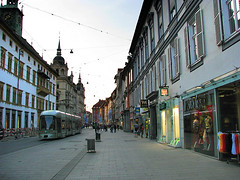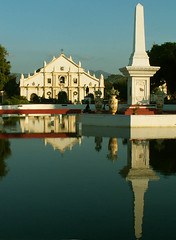The town of Vigan is a World Heritage Site that represents Asian building design and construction with Europian colonial architecture, and a preserved example of European trading town in South-east Asia.
Vigan was a coastal trading post before the Spaniards arrived. Chinese trades goods from other Asian Kingdoms for the gold, beeswax and other mountain products to the native of Cordilleras region. The term Vigan was derived from Chinese word "Bee Gan" which means "Beautiful Shore" and later change to Vigan when the Spaniards arrived.
During the time of Spanish colonialism in 16th century, conquistador Juan de Salcedo named the town as "Villa Fernadina de Vigan" in honor of King Philip II's son , Prince Ferdinand. The town was intended as trading center and not as fortress. The town became the center of trades in the North Luzon between Ilocanos, Filipinos, Chinese, Spanish from 16th-19th century and North Americans in 20th century.
The building materials used in Vigan buildings are terracotta, wood, shell, stone and lime as seen in the houses and buildings in Mena Crisologo Street with influence of Chinese and Spanish Architecture. These buildings are typically stone built in the lower storey, timber framed in the upper storey, a steeply pitched tiled roof and window panels are made with kapis shells.
Today Vigan is a tourists destination in Ilocos Sur with many interesting historical locations:
 Image via Wikipedia Image via Wikipedia |
| Vigan Cathedral/St. Paul Metropolitan Cathedral - the seat of the Archdiocese of Nueva Segovia. Burial place of the great Ilocano poet Leona Florentino. It also houses the replica of the Miraculous Santo Cristo Milagroso (the original being in Sinait, Ilocos Sur) |
 Image by Storm Crypt via Flickr Image by Storm Crypt via Flickr |
| Mena Crisologo Street - what Vigan City is known for--a street lined with Spanish Era houses and cobble-stoned streets, which led to Vigan's inscription in the list of UNESCO World Heritage Sites. Tourists can buy souvenirs or even ride a calesa (horse-drawn buggy) |
 |
Image Source
The Crisologo Museum serves as the repository of the memorabilia of both, Congressman Floro Crisologo and Governor Carmeling Pichay Crisologo |
 |
Image Source
Pagburnayan - a barrio in Vigan where tourists can see how the famous Vigan jars (burnay) are made. The traditional Jar Making industry in Vigan is believed to have been introduced by the Chinese traders in the 14th century |
 |
Image Source
Baluarte - a mini-zoo located in Salindeg where visitors can see a variety of animals (including tigers and ostriches). Not just a zoo, Baluarte is an interactive wildlife sanctuary and facility, with the breathtaking view of its dominating scenic boulders amidst trees and greens. |
 |
Image Source
Fil-Spanic Friendship Park and Buridek Museum.This destination is considered as the lung of the city. Trees are abundant in this place where visitors can relax and savor fresh air. It has a swimming pool, an open amphitheater and an added attraction-the Buridek Children’s Museum |
 |
| Image SourceHidden Garden - Located in Bulala (a barrio known for its making of bricks, pots, and other objects made of clay), it is a wonderland of greenery, with a mini-snack bar nestled somewhere in the middle |
 |
Image Source
Simbaan a Bassit which means small church is actually a cemetery chapel located in Quezon Avenue,Liberation Blvd. The only one in the region to have an "espadaña hung with bells.” A statue of the crucified Christ is found behind the main altar or the Apo Lakay of the City. |
 Image by Storm Crypt via Flickr Image by Storm Crypt via Flickr |
| Plaza Salcedo - dedicated to the memory of the great conquistador Juan de Salcedo. Located in front of the Vigan Cathedral. |
 |
| Image SourcePlaza Burgos - dedicated to the memory of Father Jose Burgos. Located beside the Vigan Cathedral. |
 |
Image Source
Syquia Mansion - the Vigan residence of Elpidio Quirino, 6th President of the Philippines. |
 |
Image Source
Father Jose Burgos' Residence - Located almost behind the Provincial Capitol. The birthplace of Father Jose Burgos, one of the three martyred Filipino priests at Bagumbayan (GOMBURZA) |
 |
| Archbishop's Residence - Located next to the Vigan Cathedral, it is the only Archbishop's Residence still in use that was built during the Spanish Era |
 |
| Quema House - the residence of the Quema family, considered by sociologist Fernando Zialcita as most representative of 18th-century Philippine architectural style |
 |
| Vigan Empanadaan - a reserved location where visitors can sample Vigan's famous empanada; as well as sinanglao (traditional hotpot made of beef innards). Located at the eastern part of Plaza Burgos |
 Image via Wikipedia
Image via Wikipedia Image by Storm Crypt via Flickr
Image by Storm Crypt via Flickr





 Image by Storm Crypt via Flickr
Image by Storm Crypt via Flickr




No comments:
Post a Comment